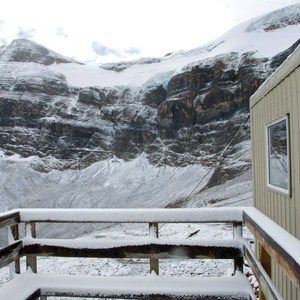Bow Peak is lovely hike with some mediocre talus and scree bashing that gains a superb summit. For those breaking into scrambling, this is a great example of a hard hike/easy scramble and a superb place to start. There isn't too much exposure, and routefinding pretty much leads to the same place with no hazards in good weather. To get there, follow the 93 North highway up toward Jasper. Just past the Helen Lake turnoff, keep your eyes peeled on the south-southwest side of the highway (left if you're heading north) for orange tape. About 200 meters ahead of the green Crowfoot Lookout sign there is a small turnoff.
The trailhead is well hidden and barely marked. There are two trailheads. The first is easy to spot and begins obviously enough, but the trail quickly disappears into marshland about 300 meters down the trail. You can just walk through the spongy open country until you get to the lake, but there is a higher risk of running into moose and bears. Also, these are fragile environments, and you should use the trails at all times. The proper trail is a 200-meter walk south of the turn off. Two orange markers and a iron bar mark the trailhead. It's a faster and much better option.
There is a river crossing 30 to 45 minutes into the hike. Be prepared. Trekking poles and appropriate footwear are highly recommended. The current can be strong (a gentle push). The rocks aren't especially sharp or slippery, so crossing with bare feet is possible. Be warned that the river will carry you some ways if you fall. Dry bags, extra socks, a change of clothes, and a towel are all good considerations.
This is a big day in the alpine, so carrying the usual 10 Essentials is recommended. Also, be wary of thunderstorms. In the Rockies they can move in very fast in the afternoon, and the upper section of this route is extremely exposed. Remember that no forecasts will warn of these, so look out for tall dark clouds.
Winter ascent
In the right conditons, this can be a great peak for winter ascents. The Grand Daddy Couloir is a popular choice for those looking for steep turns. However, for those not able to ski the steeps, the backside is a good mountaineering objective.
You will need light tourings skis or snowshoes to get up to the higher valley. Once there, you can follow the wind-blown slopes upward wearing crampons. Often the wind ravages the slopes, making it easy to avoid the avalanche-prone troughs by staying on the rocky outcroppings. However, this assesment is subject to change, and an Avalanche Safety Training 2 course is highly recommended.






























Comments
Sign In and share them.